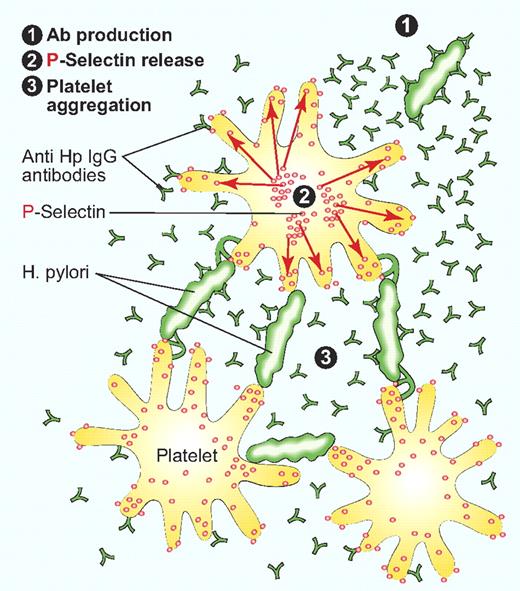“Idiopathic” thrombocytopenic purpura (ITP) is the most common autoimmune blood disorder, affecting both children and adults. The term “idiopathic” was coined because in the majority of cases, the underlying causes were unknown. In recent years, however, the list of etiologies of ITP has been steadily increasing, so the term “idiopathic” is becoming obsolete, increasingly replaced by “immune” TP. The recent entry of Helicobacter pylori to the growing list of etiologies has stirred much interest. The initial report from Italy,1 that eradication of H pylori improved ITP, was soon seconded by reports from Japan,2 then dampened by negative results from the United States.3,4 It was suggested that the discrepancy might be due to different strains of H pylori in these widely separated continents.
(1) IgG antibodies to Heliobacter pylori are generated. (2) H pylori with the IgG antibodies induce platelet activation and movement of P-selectin to the platelet surface. (3) Interaction of H pylori, Hp IGs, and P-selectin leads to platelet aggregation and apoptosis, reducing the number of ciculating platelets. Professional illustration by Paulette Dennis.
(1) IgG antibodies to Heliobacter pylori are generated. (2) H pylori with the IgG antibodies induce platelet activation and movement of P-selectin to the platelet surface. (3) Interaction of H pylori, Hp IGs, and P-selectin leads to platelet aggregation and apoptosis, reducing the number of ciculating platelets. Professional illustration by Paulette Dennis.
Although association of H pylori infection with a subgroup of ITP is now widely recognized, little is known about the underlying mechanism of the thrombocytopenia (TP). In this issue of Blood, Yeh et al offer new insight on the mechanism of “immune” TP associated with H pylori infection.5 They document induction of platelet aggregation by H pylori in vitro and show that this effect is strain-dependent. Using both the proaggregatory strain (Hp49503) and nonaggregatory strains (Hp42504, Hp51932), they demonstrate an essential role for P-selectin and Hp IgG antibody (Hp IGs) in H pylori–induced platelet aggregation. This reaction was completely inhibited by anti–P-selectin antibodies. The presence of H pylori was shown by demonstration of Hp-specific urease gene fragment in the aggregates. They propose that binding of bacteria/Hp IGs to platelet FcγRIIA receptor activates platelets to release granules and to induce surface P-selectin and von Willebrand factor, leading to aggregation. They also looked into platelet apoptosis evidenced by annexin V binding and membrane blebbing, and observed that both proaggregatory and nonaggregatory strains induced apoptosis. Taken together, they conclude that platelet aggregation and apoptosis induced by certain strains of H pylori leads to thrombocytopenia.
As we see it, this “triple play” of H pylori is summarized in the figure. First, IgG antibodies to H pylori are generated. Second, H pylori with the IgG antibodies induce platelet activation and movement of P-selectin to the platelet surface. Third, interaction of H pylori, Hp IGs, and P-selectin leads to platelet aggregation and apoptosis, reducing the number of circulating platelets.
However, details of this interaction are not fully elucidated. Yeh et al studied 2 groups of healthy subjects with normal platelet counts, comparing the uninfected group to the group infected with H pylori. They did not investigate patients with thrombocytopenia with H pylori infection or perform sequential studies before or after eradication of H pylori.
Despite questions about details, they have taken an important step toward delineating the mechanism of H pylori–mediated immune thrombocytopenia. Better understanding of the mechanisms involved may be important not only in ITP but also in more serious and familiar diseases such as cancers and atherosclerosis. H pylori is implicated in the induction and progression of lymphomas,6 other neoplasm,7 and cardiovascular disorders.8,9 Early eradication of H pylori infection has resulted in favorable outcomes.10
Among patients with H pylori–associated ITP, a significant percentage achieve lasting remission after eradication of H pylori. This fact heralds a definite sea change for hematologists in evaluating patients with “idiopathic” TP. Physicians must now dig deeper in searching out the etiology of “immune” TP, because the key to curing ITP is rooting out the underlying causes. This etiologic searching must include serology of H pylori to detect its antibodies, and if positive, presence of the bacteria must be confirmed by appropriate tests such as 13C-urea breath test, stool test, or endoscopic biopsy, followed by antibiotic therapy if confirmed. After completion of the antibiotic course, eradication of the offending bacteria must be ensured by repeating the breath test or stool test.
ITP is often like an iceberg, signaling more serious underlying problems that could lead to progression of atherosclerosis8 and neoplastic transformation.6,7 It is the duty of the hematologist to catch the opportunity to detect potential serious problems and prevent grave consequences.
Conflict-of-interest disclosure: The author declares no competing financial interests. ■


This feature is available to Subscribers Only
Sign In or Create an Account Close Modal